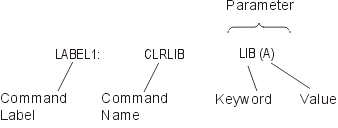The parts of a command include a command label (optional), a command name (mnemonic), and one or more parameters. The parameter includes a keyword and a value.
This figure illustrates the parts of a command:

The parts of a command include a command label (optional), a command name (mnemonic), and one or more parameters. The parameter includes a keyword and a value.
This figure illustrates the parts of a command:
